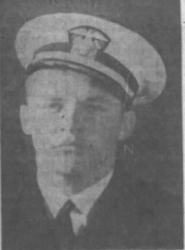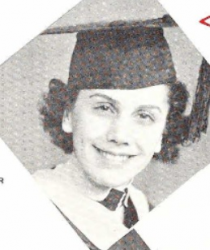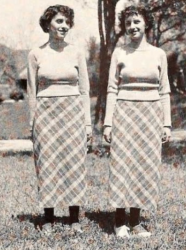
 |
|
|
||
|
JOHN JAMES VAN BUREN |
||||
|
Engagements: • World War II (1941 - 1945) |
||||
| Biography: | ||||
|
John James Van Buren Lieutenant Junior Grade, United States Navy Navy Cross & Distinguished Flying Cross John was the son of Irvin Charles Van Buren and Mary "Mae" Agnes Fardy who were married about 1911. John's siblings were; Kathryn and Martin Joseph Van Buren. Younger brother, Martin Joseph Van Buren, also enlisted in the US Navy during WWII. According to US Naval Officer records John was born on 20 July 1915. He married Selma "Sally" M Walder on 29 Oct 1939 at St Michael's Church, Pensacola, Escambia, FL. The couple took the license out in Milton, Santa Rosa, FL on 28 Oct 1939, but were married, according to the certificate of marriage, in Pensacola, FL the next day. Sally along with her twin sister, Anita, were 1937 graduates of Florida State University. Many years after John's death at Midway, Sally married James H. McWilliams on 07 May 1966 in San Diego. She died on 01 May 2003 in San Diego. John's brother, Martin Joseph Van Buren, enlisted in the US Navy on 18 Nov 1942 for service during WWII. He was released from active duty on 03 Aug 1944. John enlisted in the US Naval Reserve Aviation Training program (V-5) on 24 Mar 1938. After he completed the Elimination phase of flight training, Van Buren was released from active duty and sent home to await further orders. The orders came in late July 1938, and he reported to Naval Air Station (NAS) Pensacola where he was appointed Aviation Cadet (AvCad) on August 3, 1938. After almost a year of intensive flight training under instruction AvCad Van Buren received his naval aviator designation about August 1939 after which he was commissioned an Ensign, USNR, A-V(N), on Sep 4, 1939 in Pensacola, FL. According to the Pensacola (FL) News Journal, Wings Over Pensacola section of 05 Nov 1939, Aviation Cadet John J. Van Buren received his designation as a naval aviator, was commissioned an ensign in the Naval Reserve Force, and was transferred to VB-6, U.S.S. Enterprise. Ens Van Buren reported to Bombing Squadron 6 (VB-6) embarked on USS Enterprise (CV-6) on 31 Mar 1941. He was also transferred into the regular navy on that date. Later in the year Ens Van Buren was promoted to Lieutenant Junior Grade (Ltjg.) on 01 Nov 1941. The Enterprise was commissioned on 12 May 1938 in Newport News, VA. During 1939, Enterprise and her embarked squadrons conducted shake down cruises and workup exercises at various times. While the ship was inport the squadrons were temporarily based ashore at their assigned airfields. In Sep 1939, Enterprise became part of the Hawaiian Detachment of the U.S. Fleet whose homeport was Pearl Harbor. In Jan 1940, Enterprise was engaged in exercises in Hawaiian waters. In early Feb, she steamed for Puget Sound Navy Shipyard for an overhaul after making a brief port call in San Diego. In late May, Enterprise, her overhaul completed, returned to San Diego for about a month. She returned to Pearl Harbor on 2 July 1940. Enterprise conducted exercises from August to early Nov in the Hawaiian area. Then on 09 Nov she steamed to San Diego until 2 Dec when she got underway for the Puget Sound Navy Shipyard in Bremerton, WA. She returned to Pearl Harbor on 21 Jan 1941. During 1941, Enterprise made 13 round trips between Hawaii and San Diego from April - Nov conducting exercise cycles and squadron work-ups. During those months she also shuttled Army Air Force P-39s and P-40s, as well as, Navy aircraft from US West Coast ports to Pearl Harbor and beyond. On 28 Nov 1941, Enterprise, now operating in a war-time steaming condition, left San Diego with a cargo of Marine Fighting Squadron 211 (VMF-211) aircraft and pilots destined for Wake Island. The Marine pilots and their planes flew from Enterprise to Wake Island on 02 Dec 1941. Enterprise was scheduled to arrive back in Pearl Harbor on 06 Dec, but was delayed due to inclement weather. Fortunately, she wasn't inport on the morning of 07 Dec, but arrived later that evening. On 01 Feb 1942, the USS Enterprise air group attacked enemy installations on the Marshall Islands. Van Buren, flying 6-B-12 in VB-6's second division with his rear-seat gunner, RM3 Allen James Brost, was cited for heroic conduct in aerial combat in operations against the Japanese. During this combat he shot down one Japanese fighter and later skillfully maneuvered his plane into a position which permitted his gunner to shoot down another attacking Japanese aircraft. On 24 Feb 1942, Enterprise's Air Group attacked Wake Island. Van Buren was the pilot of 6-B-8 in VB-6s first division. On 11 March 1942, he was awarded the Distinguished Flying Cross for extraordinary heroism during these attacks. On 4 March, Enterprise’s Air Group attacked enemy installations on the Marcus Islands. Van Buren was the pilot of 6-B-8 in VB-6's second division. On 18 April, Enterprise supported the Doolittle raid. In early May, Enterprise and the aircraft carrier USS Hornet (CV-8) were dispatched to the South Pacific to assist the aircraft carriers USS Lexington (CV-2) and USS Yorktown (CV-5) who were engaged in the battle of the Coral Sea. However, before the ships arrived on-scene the battle of the Coral Sea was over. After participating in additional operations in the Central Pacific, Enterprise returned to Pearl Harbor on 26 May and began intensive preparations to meet an expected Japanese thrust at Midway Island. Enterprise got underway from Pearl Harbor on 28 May 1942, and with USS Hornet (CV-8), steamed toward a point Northeast of Midway called "Point Luck." USS Yorktown (CV-5) followed a short time later. Early on the morning on 4 Jun 1942 aircraft of the USS Enterprise's air group six launched to attack the Japanese carrier striking force that was approaching the Midway atoll. Once VB-6 found the Japanese Striking Force they were not aggressively challenged until after their dive-bombing attack on Kaga and Akagi. After their dive pull-out, VB-6, including Ltjg Van Buren, who was pilot of 6-B-13 flying in VB6's third division with his rear-seat gunner, ARM1 Harry William Nelson, Jr., had to thread their way through a gauntlet of swarming enemy fighters and a hail of anti-aircraft fire. VB-6, however, scored multiple direct hits on the enemy carriers causing fatal damage to them. Of the fifteen dive bombers from VB-6 that took off from the Enterprise that morning, only five survived the attack although six pilots and five gunners where rescued later. Enemy anti-aircraft fire and fuel exhaustion took the biggest toll on this squadron after the initial attacks. Ltjg John J. Van Buren and his gunner, ARM1 Harry W. Nelson, ran out of fuel and made a successful water landing according to eyewitnesses. They entered their life raft but were never seen again. They were listed as missing in action as of 04 Jun 1942. Their remains were unrecoverable. On 5 Jun 1943, they were "presumed" dead. Ltjg Van Buren was awarded (posthumously) the Navy Cross, the Purple Heart, the Presidential Unit Citation and ribbon, the American Defense Service Medal w/Fleet Clasp, Asiatic-Pacific Campaign Medal with two bronze battle stars, and the World War II Victory Medal.. He was also awarded the Distinguished Flying Cross for previous combat action. ------------------------- Distinguished Flying Cross citation reads: The President of the United States of America takes pride in presenting the Distinguished Flying Cross to John James Van Buren, Lieutenant, United States Navy, for extraordinary heroism while participating in aerial flight, while serving as Pilot of an airplane during the attacks upon Japanese installations in the Marshall and Gilbert Islands on 31 January 1942 and 1 February 1942. Lieutenant Van Buren, through skillful handling of his plane and excellent marksmanship, shot down one of the enemy fighters which attacked the formation in which he was flying, and then continued the attack. While returning to his carrier, Lieutenant Van Buren was jumped by another enemy fighter and his airplane was riddled with bullets. He skillfully maneuvered his craft so that his radio-gunner, who though wounded, courageously manned the free machine gun, and was able to shoot down the enemy plane. He then safely landed his airplane on his aircraft carrier despite the damage. General Orders: Bureau of Naval Personnel Information Bulletin No. 304 (July 1942) ------------------------------------- Navy Cross Citation reads: The President of the United States of America takes pleasure in presenting the Navy Cross (Posthumously) to John James Van Buren, Lieutenant, Junior Grade, United States Navy, for service as set forth in the following CITATION" "For extraordinary heroism in operations against the enemy while serving as Pilot of a Navy Dive Bomber in Bombing Squadron SIX, during the "Air Battle of Midway," against enemy Japanese forces on 4 - 6 June 1942. Defying extreme danger from concentrated anti-aircraft barrage and powerful fighter opposition, Lieutenant Junior Grade Van Buren, with bold determination and courageous zeal, led his squadron in dive-bombing assaults against Japanese naval units. Flying at a distance from his own forces which rendered return unlikely because of probable fuel exhaustion, he pressed home his attacks with extreme disregard for his own personal safety. His gallant intrepidity and loyal devotion to duty contributed greatly to the success of our forces and were in keeping with the highest traditions of the United States Naval Service.------------------------------------ USS Enterprise Presidential Unit Citation reads: For consistently outstanding performance and distinguished achievement during repeated action against enemy Japanese forces in the Pacific war area, 7 December 1941, to 15 November 1942. Participating in nearly every major carrier engagement in the first year of the war, the Enterprise and her air group, exclusive of far-flung destruction of hostile shore installations throughout the battle area, did sink or damage on her own a total of 35 Japanese vessels and shot down a total of 185 Japanese aircraft. Her aggressive spirit and superb combat efficiency are fitting tribute to the officers and men who so gallantly established her as an ahead bulwark in the defense of the American nation. Actions of the Enterprise mentioned in the citation include the Gilbert and Marshalls of 01 Feb 1942; Wake Island raid, 24 Feb 1942; Marcus Island raid, 04 Mar 1942; Battle of Midway, 4-6 Jun 1942; Occupation of Guadalcanal, 7-8 Aug 1942; Battle of Stewart Islands, 24 Aug 1942; Battle of Santa Cruz Islands, 26 Oct 1942; and Battle of Solomon Islands, 14-15 Nov 1942. ---------------------------------------- His family also received a personal commemoration from President Franklin D. Roosevelt. It reads: In grateful memory of John James Van Buren, who died in the service of his country, SEA, Pacific Area, ATTACHED U.S.S. ENTERPRISE, 5 JUNE 1943 (Presumed)*. He stands in the unbroken line of patriots who have dared to die that freedom might live and grow and increase its blessings. Freedom lives, and through it, he lives -- in a way that humbles the undertakings of most men. (Signed) Franklin D. Roosevelt, President of the United States ------------------------------------- The U.S.S. John J. Van Buren (DE-753), a Cannon-class destroyer escort was named in his honor. The keel was laid in San Pedro, CA on 18 Aug 1943 and launched on 16 Jan 1944. The ship was sponsored by Mrs. J.J. Van Buren, the widow of the ship's namesake. Construction was suspended on 6 Jun 1944 and cancelled on 1 Sept 1944. It was scrapped without being completed. ------------------------------------ Dixon Evening Telegraph (Dixon, Illinois) – 12 Nov 1942, Thu – p. 6 Navy Cross Awarded to Man From Geneseo Washington, Nov. 12 – (AP) Secretary Knox, it was announced today, has awarded the Navy cross (sic) to 16 aviators for heroism in action against the Japanese during the battle of Midway last June. Among the officers: Lieutenant (JG) John James Van Buren, 27, son of Irvin C. Van Buren, Mukwonago, Wis. Lieutenant (JG) Norman Francis Vandivier, Franklin, Ind. Ensign John Cady Lough, 26, son of George W. Lough, Geneseo, Ill. All three were listed as missing in action. -------------------------- Task Force 16 Citation Recognizing its contribution to the Doolittle Raid, 18 April 1942 On the occasion of the 50th anniversary of the Second World War, it is appropriate that we take time to reflect on the unique and daring accomplishments achieved early in the war by Task Force 16. Sailing westward under sealed orders in April 1942, only four months after the devastating raid on Pearl Harbor, Task Force 16, carrying sixteen Army B-25 bombers, proceeded into history. Facing adverse weather and under constant threat of discovery before bombers could be launched to strike the Japanese homeland, the crews of the ships and LTC Doolittle's bombers persevered. On 18 April 1942 at 14:45, perseverance produced success as radio broadcasts from Japan confirmed the success of the raids. These raids were an enormous boost to the morale of the American people in those early and dark days of the war and a harbinger of the future for the Japanese High Command that had so foolishly awakened "The Sleeping Giant." These exploits, which so inspired the service men and women and the nation live on today and are remembered when the necessity of success against all odds is required. (Signed) John H.Dalton Secretary of the Navy 15 May 1995 ------------------------- Combat Action Ribbon (CR) note: None of the Navy/Marine flight crews in the Battle of Midway were eligible for or were awarded the Combat Action Ribbon (CR). See Navy and Marine Corps Awards Manual (SECNAVINST M-1650.1 of 16 Aug 2019, Appendix 2C.1.c (3) Amplifying Guidance). It reads in part, “The CR will not be awarded in connection with aerial flight, . . . “ The CR was established in 1969 and made retroactive to 07 Dec 1941. According to the Awards Manual, when deemed appropriate, the award for aerial combat was/is the Air Medal. ------------------- Cenotaphs in Saint Peters Cemetery, East Troy, Walworth, WI; and on the Memorial of the Missing in Honolulu, HI. Bio#141 composed by Gerry Lawton (GML470) Find a Grave Memorial #165350110 |
||||
| Honoree ID: 103619 | Created by: MHOH | |||
Ribbons
Medals
Badges
Honoree Photos
 |  |  |
 |  |
 |


